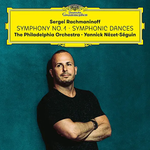|
Back
03/21/2021
Sergei Rachmaninoff: Symphony n° 1 in D minor, opus 13 [1] – Symphonic Dances, opus 45 [2]
The Philadelphia Orchestra, Yannick Nézet-Séguin (conductor)
Recording: Verizon Hall, Philadelphia, Pennsylvania (September 2018 [2] and June 2019 [1]) – 80’52
Deutsche Grammophon 483 9839 (Distributed by Universal Music) – Booklet in German and English

   
Sergei Rachmaninoff’s legendary relationship with The Philadelphia Orchestra started in the 1920s with Leopold Stokowski and continued under Eugene Ormandy’s musical directorship when the composer premiered his Symphonic Dances, his final full orchestral work. The fertile artistic legacy is present, vibrantly, on Yannick Nézet-Séguin’s latest Deutsche Grammophon live recording of the Symphonic Dances, paired with the composer’s First Symphony - ironically legendary compositions - though for very different reasons.
Rachmaninoff’s infamous 1897 St. Petersburg premiere of his First symphony, the 24-year-old composer described being in the audience as “the most agonizing hour” as his symphony was being mangled with “grating dissonances and ill-tuned playing” by composer Alexander Glazunov, who was conducting while drunk (aka CWD). Even Glazunov’s fiancé admitted that, yes, “he wrecked it.”, and the critics were summarily merciless toward Rachmaninoff because of it. The public debacle caused the composer to suffer a nervous breakdown and, subsequently, he suffered composer’s block for three years.
The debacle of Rachmaninoff’s symphonic debut was finally vindicated in Russia, receiving every acclaim in its Moscow premiere in 1945, but, unfortunately, two years after Sergei’s death. Meanwhile, Rachmaninoff had finally been regarded as one of the era’s most celebrated composers, and he had much better luck working in Philadelphia, first, with a very sober Leopold Stokowski on several commissions. The creative bond, long established with the orchestra, continued during Eugene Ormandy’s directorship. And the composer’s works are so celebrated by the orchestra that their sound logo in promotions is the vaulting fanfare from Symphonic Dances.
Yannick Nézet-Séguin puts his stamp on Symphony n° 1 with detail, and key to its cohesive structure, nuanced and illuminating tempos that calibrate the pulse and orchestral breadth of Rachmaninoff’s debut symphony. The opening movement, “Grave”, in this performance, lands like a sonic thunderbolt that gives way to meditative orchestral dialogues and a lyrical yearning. Nézet-Séguin leans into the whispering passages that are just as dramatic as the percussive/brass heralds. There is unabashed joie de vivre in the woodwinds that hover over the rumbling brass. That soaring spirit is contrasted in the third movement with the “Larghetto” reflecting the darker shadows of the composer’s symphonic drama. The fourth movement’s conventional structures and fortissimo swirl as the orchestra thunders on to a triumphal finish.
In 1940, Rachmaninoff was back in Philadelphia, working closely with Ormandy on his ‘Symphonic Dances’, to elicit the full artistry of The Philadelphia Orchestra performing in the Academy of Music, the oldest opera house in the United States and with architecture and furnishings that swallowed dimensions of sound but muscled the orchestra’s clarity under Ormandy. That signature sound of the Philadelphia strings was achieved, in part, with non-synchronization (with the so called long bowing techniques). Nézet-Séguin has just as much ‘sound’ clarity in symphonic works as he does in his chamber music. Nézet-Séguin brings balance on Symphonic Dances that illuminates its organic propulsive energy, and vitally, never leaning on the sonic hook. Just as captivating is the second movement, “Andante”, with its haunting stop-time waltz for the ages.
The Philadelphia Orchestra seems to revel in the musical mystique of the Symphonic Dances, as does the living musical legacy of Rachmaninoff’s synthesis of the storied Philadelphia ‘sound’.
Lewis J. Whittington
|